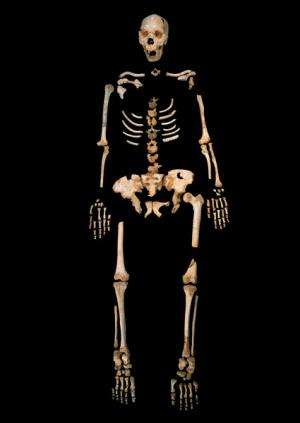Oldest hominin DNA sequenced

Using novel techniques to extract and study ancient DNA researchers at the Max Planck Institute for Evolutionary Anthropology in Leipzig, Germany, have determined an almost complete mitochondrial genome sequence of a 400,000-year-old representative of the genus Homo from Sima de los Huesos, a unique cave site in Northern Spain, and found that it is related to the mitochondrial genome of Denisovans, extinct relatives of Neandertals in Asia. DNA this old has until recently been retrieved only from the permafrost.
Sima de los Huesos (SH), the "bone pit", is a cave site in Northern Spain that has yielded the world's largest assembly of Middle Pleistocene hominin fossils, consisting of at least 28 skeletons, which have been excavated and pieced together over the course of more than two decades by a Spanish team of paleontologists led by Juan-Luis Arsuaga. The fossils are classified as Homo heidelbergensis but also carry traits typical of Neandertals. Until now it had not been possible to study the DNA of these unique hominins.
Matthias Meyer and his team from the Max Planck Institute for Evolutionary Anthropology in Leipzig, Germany, have developed new techniques for retrieving and sequencing highly degraded ancient DNA. They then joined forces with Juan-Luis Arsuaga and applied the new techniques to a cave bear from the Sima de los Huesos site. After this success, the researchers sampled two grams of bone powder from a hominin thigh bone from the cave. They extracted its DNA and sequenced the genome of the mitochondria or mtDNA, a small part of the genome that is passed down along the maternal line and occurs in many copies per cell. The researchers then compared this ancient mitochondrial DNA with Neandertals, Denisovans, present-day humans, and apes.

From the missing mutations in the old DNA sequences the researchers calculated that the Sima hominin lived about 400,000 years ago. They also found that it shared a common ancestor with the Denisovans, an extinct archaic group from Asia related to the Neandertals, about 700,000 years ago. "The fact that the mtDNA of the Sima de los Huesos hominin shares a common ancestor with Denisovan rather than Neandertal mtDNAs is unexpected since its skeletal remains carry Neandertal-derived features", says Matthias Meyer. Considering their age and Neandertal-like features, the Sima hominins were likely related to the population ancestral to both Neandertals and Denisovans. Another possibility is that gene flow from yet another group of hominins brought the Denisova-like mtDNA into the Sima hominins or their ancestors.

"Our results show that we can now study DNA from human ancestors that are hundreds of thousands of years old. This opens prospects to study the genes of the ancestors of Neandertals and Denisovans. It is tremendously exciting" says Svante Pääbo, director at the Max Planck Institute for Evolutionary Anthropology.
"This unexpected result points to a complex pattern of evolution in the origin of Neandertals and modern humans. I hope that more research will help clarify the genetic relationships of the hominins from Sima de los Huesos to Neandertals and Denisovans" says Juan-Luis Arsuaga, director of the Center for Research on Human Evolution and Behaviour. The researchers are now pursuing this goal by focusing on retrieving DNA from more individuals from this site and on retrieving also nuclear DNA sequences.
More information: Matthias Meyer, Qiaomei Fu, Ayinuer Aximu-Petri, Isabelle Glocke, Birgit Nickel, Juan-Luis Arsuaga, Ignacio Martínez, Ana Gracia, José María Bermúdez de Castro, Eudald Carbonell and Svante Pääbo, A mitochondrial genome sequence of a hominin from Sima de los Huesos, Nature, 4 December 2013 DOI: 10.1038/nature12788
Journal information: Nature
Provided by Max Planck Society





















